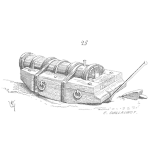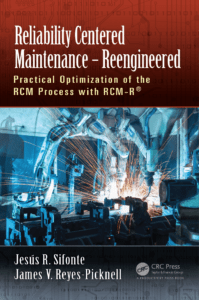
Reliability Centered Maintenance (RCM) is without doubt the most effective method to determine your failure management policies, yet it is sometimes seen as an expensive and time consuming endeavor used to produce what some (mistakenly) believe they can get from manufacturer recommendations and other sources. The naysayers see it as a “gold plated” approach to a relatively simple challenge – produce a decent maintenance program.
They couldn’t be more wrong! And that error, could get them into a lot of trouble if circumstances align against them.
RCM is a process used to ensure that physical assets continue to do what their users require of them in their present operating context. It is a process, it is not a result. For your critical assets it’s a must. It helps you define what you need to do to sustain the functioning of those assets in your operating environment (not some generic environment, nor someone else’s). With RCM you manage consequences of failures and risks. You use engineering concepts within its decision logic to select the most appropriate policies to deal with failures. It looks at failure modes, which occur at a very granular level of detail. For each you make a decision and lower your risks. RCM has evolved beyond the typical engineering use of FMEA (Failure Modes and Effects Analysis). Those use parts as a starting point for analysis and require a lot of effort. RCM starts with functions as the basis for its FMEA (the first 4 questions in the method), resulting in a much more condensed and effective analysis.
Maintenance is not about repairs, it is best used as a means to sustain the performance of functions that a user may require of machinery in a defined operating context. That context is very important – change it, and you can change the ways in which your asset fails and the consequences of those failures. A decision made in one company’s context may be entirely inappropriate in another’s. e.g.: A pump used for water won’t fail the same way as an identical pump used for caustic soda.
The successful implementation of Reliability Centered Maintenance (RCM) will lead to a quantifiable lowering of asset related risks, a measurable increase in cost effectiveness (and lower costs), increases in machine and systems’ uptime, increases in output, and a greater understanding of the risks that the organization is managing. Of course it has its costs – up front training, facilitation of analysis projects, as well as the time your maintainers and operators will consume during the analysis. It also has its benefits – far outweighing those costs in most organizations where there is a high level of dependency on your physical assets to work dependably. We recommend it for critical assets to avoid overdoing analysis effort on those assets where failures may be tolerable.
Where it began
RCM began in the aircraft industry and moved into other industries in the early 1990’s. In 1991, John Moubray (d) published his first book on the subject. Since then, various RCM methods have proliferated. Many have sought to capitalize on the success of its early adopters. Some of those methods worked well, many did not. There was considerable confusion and disagreement over what exactly was the RCM process, so in 1998, with the encouragement of the US Secretary of Defence, the criteria for RCM was laid out in technical standard SAE JA-1011, “Evaluation Criteria for RCM Processes”. That standard sets out the minimum criteria that any process should meet before it can be called RCM. It requires that the 7 questions below be asked, and in the order that they are listed:
- What is the item supposed to do and its associated performance standards?
- In what ways can it fail to provide the required functions?
- What are the events that cause each failure?
- What happens when each failure occurs?
- In what way does each failure matter?
- What systematic task can be performed proactively to prevent, or to diminish to a satisfactory degree, the consequences of the failure?
- What must be done if a suitable preventive task cannot be found?
The above questions seem fairly simple to answer at first blush. However, there is a great deal of knowledge needed to answer them correctly, and they should only be applied in your operating context. Answering them requires a combination of operational and maintenance experience and occasionally, some specialist engineering help.
The term “reliability centered maintenance” was first used in public papers authored by Tom Matteson, Stanley Nowlan, Howard Heap, and other senior executives and engineers at United Airlines (UAL) to describe a process used to determine the optimum maintenance requirements for aircraft. After being created by the commercial aviation industry, RCM was adopted by the U.S. military (beginning in the mid-1970s) and by the U.S. commercial nuclear power industry (in the 1980s).
Starting in the late 1980s, an independent initiative led by John Moubray corrected some early flaws in the process, and adapted it for use in a wider range of industries. At roughly the same time, Anthony (Mac) Smith also published a book on the subject and began to commercialize it. John and Mac were the two most responsible for popularizing the method, which has stood the test of time.
RCM today
Economic pressures, increasingly global competition, tied with advances in lean thinking, efficiency methods and increasingly more capable technology tools, keep us busy managing a lot of complexity. Misguided “lean” initiatives aimed at reducing staff size rather than waste have left a lot of organizations over-lean (anorexic). Consequently, those companies struggle to make the few people required to carry out an RCM available. With the increase of internet use and the increasingly youthful workforce who are “digital natives”, there is also a growing (and erroneous) belief that somewhere on the internet, there is an RCM solution that will fit. Sadly, there is “no app for that”.
In fairness, if there wasn’t so much diversity in operating contexts, then there might be. But every company, every site, every system, every application of a given technology, are always different and unique. In fact just about anyone I speak with will insist that their operation is quite unique in some way.
As you are well aware, a reliability culture moves its organization away from breakdown and repair mentality to a culture of asset management. Reliability is the cornerstone of risk identification and mitigation.
Risk management is becoming more and more of a focus in board rooms and by the public. Tolerance for mistakes is very low – and it should be. We know better and the public knows we know better. While mistakes can be made and we recognize that we are only human, the tolerance is low. The legal profession has driven us in a very litigious direction so whenever something goes wrong, fingers are pointed, blame assigned and someone pays.
Believe it or not, industrial incidents are often foreseen. Yet, they are allowed to happen – often through knowing neglect at the corporate level. Injure or kill employees or anyone else in an accident and you will be under the microscope and facing potential fines, and even jail time. Suffer an environmental incident and you might find yourself shut down or facing huge costs in litigation, compensation and fines.
RCM is one of the best ways to define risks, what to do about them and to provide yourself with an “audit trail” of what you’ve done that would stand up very well to external scrutiny. RCM is incredibly successful if applied correctly. It can be used to improve your safety, environmental performance, output and operating costs. You an learn how to achieve these results with RCM training. From the early 90’s until 2015, there’s been no real evolution in RCM and we saw a void.
Since 2015, Conscious Asset has been offering its own brand of RCM and in 2017, together with Jesus Sifonte and his companies in Puerto Rico, we produced a joint effort resulting in “Reliability Centered Maintenance – Re-engineered” (RCM-R®). That updated method is the first serious look at the entire RCM process and it’s fitness for purpose in recent years. It’s early adopters have been pointing out just how much more advanced it is than other (often older) methods and even those purporting to be “new”.
 Our book includes a great deal on the reliability mathematics and how to apply it. We don’t just provide formulas to follow blindly – we show how they were derived. We link RCM to several international standards that didn’t exist when Moubray and Smith did their work. Those are all intended to help manage reliability information and risks in today’s increasingly challenging business environment. We’ve also included information on Criticality Analysis and Asset Hierarchies – needed pre-requisites to a good reliability program. Our RCM-R® training courses apply reliability centered maintenance best practices and use real life case studies to explore the techniques you need to re-define your maintenance programs. You’ll develop a greater knowledge about asset failure consequences and how to manage them. Learn more here.
Our book includes a great deal on the reliability mathematics and how to apply it. We don’t just provide formulas to follow blindly – we show how they were derived. We link RCM to several international standards that didn’t exist when Moubray and Smith did their work. Those are all intended to help manage reliability information and risks in today’s increasingly challenging business environment. We’ve also included information on Criticality Analysis and Asset Hierarchies – needed pre-requisites to a good reliability program. Our RCM-R® training courses apply reliability centered maintenance best practices and use real life case studies to explore the techniques you need to re-define your maintenance programs. You’ll develop a greater knowledge about asset failure consequences and how to manage them. Learn more here.
 Ask a question or send along a comment.
Please login to view and use the contact form.
Ask a question or send along a comment.
Please login to view and use the contact form.
Leave a Reply